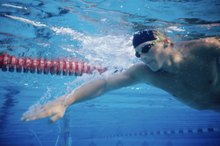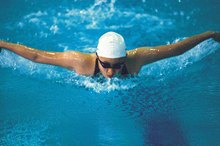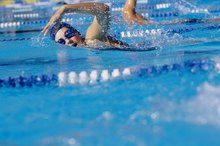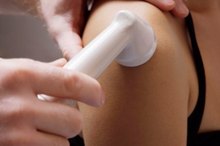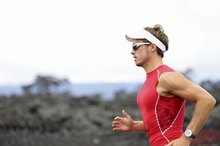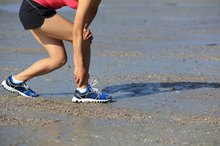Elbow Pain From Swimming
Swimming is considered an excellent aerobic exercise because it forces you to repeatedly moving large muscles of the body. However, with repetitive muscle movement, not enough rest between swimming workouts and improper stretching, elbow pain often occurs. Elbow pain from swimming may be a result of overuse while you perform certain types of strokes.
Introduction
Elbow pain usually occurs in competitive swimming, with the butterfly stoke and breaststroke being the most common form of swimming to cause problems around the elbow, according to the "Sports Injury Bulletin," a London-based newsletter. Freestyle swimming does the least amount of injury to the elbow, and is more likely to cause shoulder injury. The reason for the elbow pain in those types of strokes is because the swimmer bends the elbow and holds it higher than the hand in order to pull the body through the water. This angle is the most efficient in pulling the water backwards and giving the hand maximum thrust.
- Elbow pain usually occurs in competitive swimming, with the butterfly stoke and breaststroke being the most common form of swimming to cause problems around the elbow, according to the "Sports Injury Bulletin," a London-based newsletter.
- The reason for the elbow pain in those types of strokes is because the swimmer bends the elbow and holds it higher than the hand in order to pull the body through the water.
Tennis Elbow
Ankle Pain & Swimming
Learn More
Lateral epicondylitis, also known as tennis elbow, occurs when you repeatedly perform the breaststroke or the butterfly stroke, in which the elbow is bent, the forearm is facing downward and the upper arm rotates toward the center of the body. The repeated motion causes the tissue to become inflamed and produces tiny tears in the tendons that attach to the bony point outside of the elbow and the forearm muscle.
Treating Elbow Pain
Treating overuse injuries involve using the acronym PRICEMM. It stands for protection, which means isolating the elbow from other exercise; rest, which means the elbow should be rested; ice, which means the elbow should be put on ice; compression, which means it should be wrapped up; elevation, which means the elbow should stay elevated, medication if needed for the pain and the final is modalities, which means that if the injury is severe physical therapy may need to take place.
Considerations
Shoulder Popping While Rotating During Swimming
Learn More
Water aerobics or water walking are good alternatives to swimming while you wait for your your elbow injury to heal. Proper stretching could also help prevent and alleviate elbow pain from swimming. One stretching technique, known as the forearm flexor, involves holding your arm out straight in front of you with your elbow extended and your palms facing up. Then grab your fingers with your other hand and pull your hand down; hold for 20 to 30 seconds. Another technique, known as the forearm extenders, involves holding your arm out straight with your elbow extended and your palm facing down. Then grab your fingers with your other hand and pull your hand down; hold for 20 to 30 seconds.
- Water aerobics or water walking are good alternatives to swimming while you wait for your your elbow injury to heal.
- Another technique, known as the forearm extenders, involves holding your arm out straight with your elbow extended and your palm facing down.
Related Articles
References
- MayoClinic.com; Causes of Tennis Elbow; Oct. 21, 2010
- Vaquero-picado A, Barco R, Antuña SA. Lateral epicondylitis of the elbow. EFORT Open Rev. 2016;1(11):391-397. doi:10.1302/2058-5241.1.000049
- Amin NH, Kumar NS, Schickendantz MS. Medial epicondylitis: evaluation and management. J Am Acad Orthop Surg. 2015;23(6):348-55. doi:10.5435/JAAOS-D-14-00145
- Blackwell JR, Hay BA, Bolt AM, Hay SM. Olecranon bursitis: a systematic overview. Shoulder Elbow. 2014;6(3):182-90. doi:10.1177/1758573214532787
- Truong J, Ashurst JV. Septic Bursitis. Treasure Island, Fl: StatPearls Publishing; 2019.
- Varacallo M, Mair SD. Proximal Biceps Tendinitis and Tendinopathy. Treasure Island, Fl: StatPearls Publishing; 2019.
- Bellapianta JM, Lavelle WF, Lavelle ED, Onyedika I, Economedes D, Whipple R. Hand Pain. Current Therapy in Pain. 2009:156-167. doi:10.1016/b978-1-4160-4836-7.00021-3
- Moradi A, Ebrahimzadeh MH, Jupiter JB. Radial Tunnel Syndrome, Diagnostic and Treatment Dilemma. Arch Bone Jt Surg. 2015;3(3):156-62.
- Saeed W, Waseem M. Elbow Fractures Overview. Treasure Island, Fl: StatPearls Publishing; 2019.
- Athwal GS. Elbow Dislocation - OrthoInfo - AAOS. OrthoInfo: American Academy of Orthopaedic Surgeons. Oct 2017.
- Bursitis. MedlinePlus. Sept 12, 2019.
- Harvard Health Publishing. The importance of stretching. Harvard Health. Sept 2013.
- Tennis Elbow (Lateral Epicondylitis) - OrthoInfo - AAOS. OrthoInfo: American Academy of Orthopaedic Surgeons. Jul 2015.
- Shah CM, Calfee RP, Gelberman RH, Goldfarb CA. Outcomes of rigid night splinting and activity modification in the treatment of cubital tunnel syndrome. J Hand Surg Am. 2013;38(6):1125-1130.e1. doi:10.1016/j.jhsa.2013.02.039
- Biceps Tendinitis - OrthoInfo - AAOS. OrthoInfo: American Academy of Orthopaedic Surgeons. Feb 2016.
- Kinaci A, Neuhaus V, Ring D. Surgical procedures of the elbow: a nationwide cross-sectional observational study in the United States. Arch Bone Jt Surg. 2015;3(1):13-8.
- American Academy of Orthopedic Surgeons. (n.d.). Elbow Arthroscopy.
- Kane SF. Evaluation of Elbow Pain in Adults. Am Fam Physician. 2014 Apr 15;89(8):649-57.
- O'Connor FG. (2018). Evaluation of elbow pain in adults. Fields KB, ed. UpToDate. Waltham, MA: UpToDate Inc.
- Sources:American Academy of Orthopedic Surgeons (n.d.). Elbow Fractures in Children.
Writer Bio
Dustin Bogle is an experienced personal trainer, group fitness instructor, nutritionist and fitness article writer. His articles have been featured in "Daily Press" newspaper and "Fresh Ink" newspaper.
